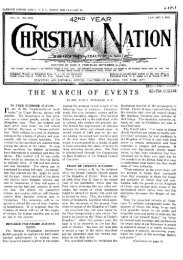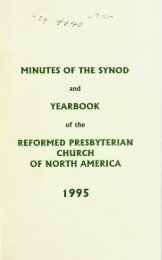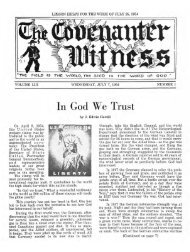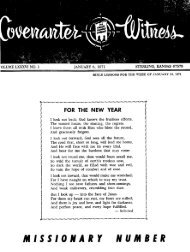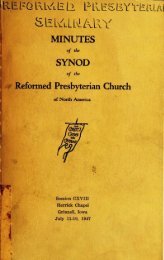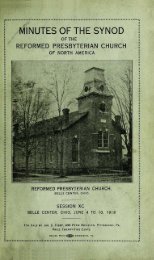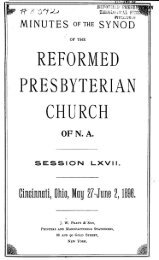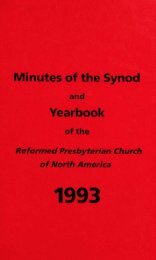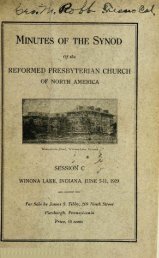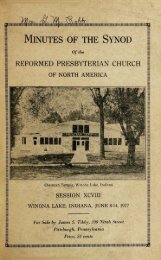- Page 1 and 2:
Missionary NumberLESSON HELPS FOR T
- Page 3 and 4:
ight"Current EventsBy Prof. William
- Page 5 and 6:
missionary."missionary."personality
- Page 7 and 8:
And Now Africa !R. V. HerboldIt cou
- Page 9 and 10:
QUESTIONSgeneration'Lesson Helps fo
- Page 11 and 12:
was,"readers.". . . HeAlfredconsist
- Page 13 and 14:
mater."government."youth."world."po
- Page 15 and 16:
Honorable Robert T.of South Carolin
- Page 17 and 18:
place?"you"again?"LESSONS FOR THE W
- Page 19 and 20:
agent"Current EventsBy Prof. Willia
- Page 21 and 22:
state"Teaching the BibleBut a recen
- Page 23 and 24:
people,"Christ Is Greater Than the
- Page 25 and 26:
nation."'Rep. Siler said it was his
- Page 27 and 28:
uge."serve."peace,"you?"vain?"wife.
- Page 29 and 30:
Reformed Presbyterian Woman's Assoc
- Page 31 and 32:
WALTON Association Dues $14.00Walto
- Page 33 and 34:
ejoicing."saved"BIBLE LESSON FOR TH
- Page 35 and 36:
... Bechild."mouth."Jeremiah,the He
- Page 37 and 38:
shame?"rebuke"rebuke."me."contains
- Page 39 and 40:
ment."etc."The Sole Interpreter of
- Page 41 and 42:
commandments."generation."You said
- Page 43 and 44:
nic."songs."them and He knew all th
- Page 45 and 46:
Beatitudes for a HousewifeBlessed i
- Page 47 and 48:
the best expression of regard that
- Page 49 and 50:
. thetoECHOES NUMBERBIBLE LESSON FO
- Page 51 and 52:
Current EventsBy Prof. William H. R
- Page 53 and 54:
well!"me.""In Thee my soul hath she
- Page 55 and 56:
supply"cooperative"it not only had
- Page 57 and 58:
3YOUNG PEOPLE'SSECRETARYoung PeophS
- Page 59 and 60:
prophet."angel."son."2. Are we maki
- Page 61 and 62:
Church NewsDENISONMiss Kathleen McC
- Page 63 and 64:
generations"children gave a good po
- Page 65 and 66:
itual,"ritual."structure"gross."Mis
- Page 67 and 68:
ever."attendance."position"ways."pe
- Page 69 and 70:
etc."in Japanese is in preparation.
- Page 71 and 72:
Vacation Bible Schools in CyprusDea
- Page 73 and 74:
effect."world"provided"ocean."girls
- Page 75 and 76:
attend."evangelism"upholds the Tora
- Page 77 and 78:
glorious."sheep."verily."lated to o
- Page 79 and 80:
Church Newsfaith once delivered to
- Page 81 and 82:
crime,"right."ear!"BIBLE LESSONS FO
- Page 83 and 84:
mercy."read."men."now."Vineyard Gle
- Page 85 and 86:
ed."saints."saved."present"easy."wa
- Page 87 and 88:
unfeigned"of God's provision for th
- Page 89 and 90:
you."out."me associate with princes
- Page 91 and 92:
emies'alert"else."plain."me."one of
- Page 93 and 94:
stakes."winning."Recommendations of
- Page 95 and 96:
Y.; Jim Pennington, Beaver Falls, P
- Page 97 and 98:
unclean!"us?"BIBLE LESSONS FOR THE
- Page 99 and 100:
preference."purposes."perform."mark
- Page 101 and 102:
purpose."good."purpose."good."you."
- Page 103 and 104:
night."spiritual"alone."moved."sinn
- Page 105 and 106:
the last part of that year Garrett
- Page 107 and 108:
Lesson Helps for the Week of Septem
- Page 109 and 110:
. . Draw. Resist.me."sinned"sin."pe
- Page 111 and 112:
lough year. Both Mr. and Mrs. Boyle
- Page 113 and 114:
not."good."BIBLE LESSONS FOR THE WE
- Page 115 and 116:
craps."world,"slavery."Vineyard Gle
- Page 117 and 118:
comin'not,"morning?"always."an'an's
- Page 119 and 120:
soul?"some"the souls of men. "What
- Page 121 and 122:
goest."goest."shore."Lesson Helps f
- Page 123 and 124:
us."COMMENTSOur last study in this
- Page 125 and 126:
us,"all."Russell. Everyone regrette
- Page 127 and 128:
Paul Coleman of Kansas City.Rev.and
- Page 129 and 130:
sinner"sent"new"peace"rest"ECHOES N
- Page 131 and 132:
eactors,"Current EventsBy Prof. Wil
- Page 133 and 134:
suggest?"crown.'sinners."many."exte
- Page 135 and 136:
man."wise."path"another."you"name."
- Page 137 and 138:
myself."DESYOUNG PEOPLE'SSECRETARYs
- Page 139 and 140:
over"memorials."me."church"The lead
- Page 141 and 142:
called."eousness"garment"man,"city,
- Page 143 and 144:
"M SImsks~..;riii*.. ., : :;'M...L.
- Page 145 and 146:
spirit"and"seeking."Missionary Numb
- Page 147 and 148:
S;,camps,"groups."*pastors'Vineyard
- Page 149 and 150:
soon."years'need,"us"close of the w
- Page 151 and 152:
News Briefs From SyriaBy Eunice L.
- Page 153 and 154:
shrined,"man."conversion."work."med
- Page 155 and 156:
city."city."valor."Lesson Helps for
- Page 157 and 158:
else."goods?"gregation."all"to Jesu
- Page 159 and 160:
me."are fine cooks as well as missi
- Page 161 and 162:
BIBLE LESSONS FOR THE WEEK OF OCTOB
- Page 163 and 164:
glory"people."Vineyard GleaningsBan
- Page 165 and 166:
essential."eyes."side."mark"run!"al
- Page 167 and 168:
PAUL COLEMANWords of sympathy spoke
- Page 169 and 170:
see,"attend."away."away"HOW TO ENLA
- Page 171 and 172:
people."affirmation."poem with a la
- Page 173 and 174: good."Church NewsThe Board of Forei
- Page 175 and 176: Miss Annetta Knowles, Mrs. TrumanHu
- Page 177 and 178: acquire."BIBLE LESSONS FOR THE WEEK
- Page 179 and 180: Vineyard GleaningsSenate Review of
- Page 181 and 182: vain."creature."Failure ThatSucceed
- Page 183 and 184: en,"objectives.'and then see that t
- Page 185 and 186: country!"again,"people"References:
- Page 187 and 188: air,"whatsoever."evil,"me."world."u
- Page 189 and 190: 2. Anderson, Mrs. C. P.3. Beatty, M
- Page 191 and 192: nant,"Eight of our C.Y.P.U. members
- Page 193 and 194: ECHOES NUMBERBIBLE LESSONS FOR THE
- Page 195 and 196: street,"Current EventsMISSION TO MO
- Page 197 and 198: navigation."44A Tavern in the Sky"B
- Page 199 and 200: us."ministers'Ministers'WivesNowada
- Page 201 and 202: ..DESPEOPLE'SSECRETARYoung People6.
- Page 203 and 204: pleased."their army at a place call
- Page 205 and 206: cometh."onel"saved."say."you,"Speci
- Page 207 and 208: serve."TOPEKA NEWS ITEMSOn August 2
- Page 209 and 210: Missionary NumberBIBLE LESSONS FOR
- Page 211 and 212: citizen."religion."Vineyard Gleanin
- Page 213 and 214: straight."peasants!"way."inmeans."p
- Page 215 and 216: in'eat,'that we may be faithful thi
- Page 217 and 218: whale."shish."shown."promise."alway
- Page 219 and 220: me."everlasting."us."fully harnesse
- Page 221 and 222: 4. Send dues to the Treasurer of th
- Page 223: John David Greenwood was bornSeptem
- Page 227 and 228: profanity."cipline"Vineyard Gleanin
- Page 229 and 230: ender?"says "That any person may be
- Page 231 and 232: possible,"She considered the girl a
- Page 233 and 234: cheerful."world."medicine."setback.
- Page 235 and 236: an."might.""I'll go if you come, to
- Page 237 and 238: wage."wealth is set forth by James
- Page 239 and 240: old,"posures"sin."right,"you."right
- Page 241 and 242: whipped."suggestion?"sir."BIBLE LES
- Page 243 and 244: minors'association"Vineyard Gleanin
- Page 245 and 246: wall?"apparel."wrong."sir."wall,"vo
- Page 247 and 248: saved"ago."our ills and guess at th
- Page 249 and 250: you?"ance."they had had victory so
- Page 251 and 252: name."eternity"victory."the power,
- Page 253 and 254: much"course which it is following a
- Page 255 and 256: Mrs. Kenneth Sanderson, Miss Marjor
- Page 257 and 258: ground?"ECHOES NUMBERBIBLE LESSONS
- Page 259 and 260: Current EventsProf. William H. Russ
- Page 261 and 262: use this year. In the center of the
- Page 263 and 264: class"need."wife,"sermon?"of the hu
- Page 265 and 266: convenient"0YOUNG PEOPLE'SSECRETARY
- Page 267 and 268: come'come"you."come,"you."Lesson He
- Page 269 and 270: another."repenteth"want".."Under th
- Page 271 and 272: We thank the Missionettes for their
- Page 273 and 274: Missionary NumberBIBLE LESSONS FOR
- Page 275 and 276:
world."Glimpses of the Religious Wo
- Page 277 and 278:
man?"way."of my hands, and Israel m
- Page 279 and 280:
esons'pital."anyway,"services."pros
- Page 281 and 282:
praise."man?"name."name."ciples."Le
- Page 283 and 284:
not."church."to the widow,"WeepThen
- Page 285 and 286:
Hrs. Anna McKelvy, Glen Sandfield,O
- Page 287 and 288:
marrieds"overnight,"country,"have d
- Page 289 and 290:
NATIONAL REFORM NUMBERBIBLE LESSONS
- Page 291 and 292:
area"Current EventsProf. William H.
- Page 293 and 294:
world."providences"place"everything
- Page 295 and 296:
-10,000,-Number printed in 1953Numb
- Page 297 and 298:
power."name."earth."so."might."me."
- Page 299 and 300:
soul?"am?"send?"me,"up,"purged."us.
- Page 301 and 302:
work."Church NewsMr. Clair Kahl of
- Page 303 and 304:
promising"all."Minutes of the Refor
- Page 305 and 306:
out!"gan."view"am"BIBLE LESSONS FOR
- Page 307 and 308:
praying."Glimpses of the Religious
- Page 309 and 310:
earth"observation."satisfied."repen
- Page 311 and 312:
many"ungodly."us."subject."old"salv
- Page 313 and 314:
up."ceasing"queen."me."world"coat,"
- Page 315 and 316:
much."away?"months"One cannot worry
- Page 317 and 318:
coholism."through the efforts of ou
- Page 319 and 320:
ness""It means for us all good, all
- Page 321 and 322:
gether"praise"maker"ever"giver"ear"
- Page 323 and 324:
spirit"government,"Current EventsPr
- Page 325 and 326:
wine."accusers."works."world."you."
- Page 327 and 328:
ejoice"self"end."sorrows"wealth"you
- Page 329 and 330:
_A THANKSGIVING PROCLAMATION *By Th
- Page 331 and 332:
neighbor?"cy."wise."pray."SABBATHSC
- Page 333 and 334:
eward"men"'PROPOSED CHURCHThis isth
- Page 335 and 336:
ard."you."good,"eluding visitors fr
- Page 337 and 338:
mine."way"nothing."receive?"ECHOES
- Page 339 and 340:
evils."citizens."war"Current Events
- Page 341 and 342:
picture."wretchedness."with."have f
- Page 343 and 344:
great"order."up"mine"salvation."sin
- Page 345 and 346:
one,"waters."up"speeches"men."paper
- Page 347 and 348:
sore."sons?"er."something about him
- Page 349 and 350:
price."price,"wood?"up,"all his out
- Page 351 and 352:
ended"ered-dish"missionaries while
- Page 353 and 354:
fl!*1J**w\KroMissionary numberBIBLE
- Page 355 and 356:
Current EventsProf. William H. Russ
- Page 357 and 358:
society,"Century, of the decline of
- Page 359 and 360:
Book Room. He has since grown much
- Page 361 and 362:
elbow."village."get out to bring th
- Page 363 and 364:
you?"sinned"manger"mighty"ground."m
- Page 365 and 366:
ecord."Clause? He'd better stay out
- Page 367 and 368:
aquainted."exposition."COLLEGE HILL
- Page 369 and 370:
BIBLE LESSONS FOR THE WEEK OF JANUA
- Page 371 and 372:
Current EventsProf. William H. Russ
- Page 373 and 374:
away"reprobate"obedience."cup."righ
- Page 375 and 376:
slaveholders."pure."money,"BOOK REV
- Page 377 and 378:
us"see."stand."us."world."places."t
- Page 379 and 380:
call."Church NewsGENEROUS PREMIUMSF
- Page 381 and 382:
saints."They are now located at 102
- Page 383 and 384:
come."retary of World Vision, Inc.,
- Page 385 and 386:
BIBLE LESSONS FOR THE WEEK OF JANUA
- Page 387 and 388:
Current EventsProf. William H. Russ
- Page 389 and 390:
stayed."quickly"night"too are Coven
- Page 391 and 392:
written"vain"not""MyLord Has Not To
- Page 393 and 394:
sun."sun,"worth?"me!"good?"sun,"sun
- Page 395 and 396:
share"prayer,"not."groups."saries."
- Page 397 and 398:
out."this pre-Christmas advertising
- Page 399 and 400:
letter one. We pray that with God's
- Page 401 and 402:
period."solution"me."ECHOES NUMBERB
- Page 403 and 404:
Current EventsProf. William H. Russ
- Page 405 and 406:
storehouse."offerings"steal."reward
- Page 407 and 408:
ighteous"sins"eyes"TribulationIn th
- Page 409 and 410:
wonderful,"people"soul."YOUNG PEOPL
- Page 411 and 412:
you."ance."perish."man, he was call
- Page 413 and 414:
the home of Mr. and Mrs. Harold Aul
- Page 415 and 416:
GROUPS OF THE 1955 COVAMLKI CAMP (O



